Key takeaways:
- Storytelling enhances emotional connections and community in the classroom, fostering empathy and diverse perspectives among students.
- It improves memory retention and critical thinking skills by making information more relatable through narratives.
- Engaging storytelling techniques, such as descriptive language and sensory details, captivate students’ attention and enhance learning experiences.
- Personal anecdotes and cultural narratives can unlock student engagement, creating a safe space for vulnerability and connection.
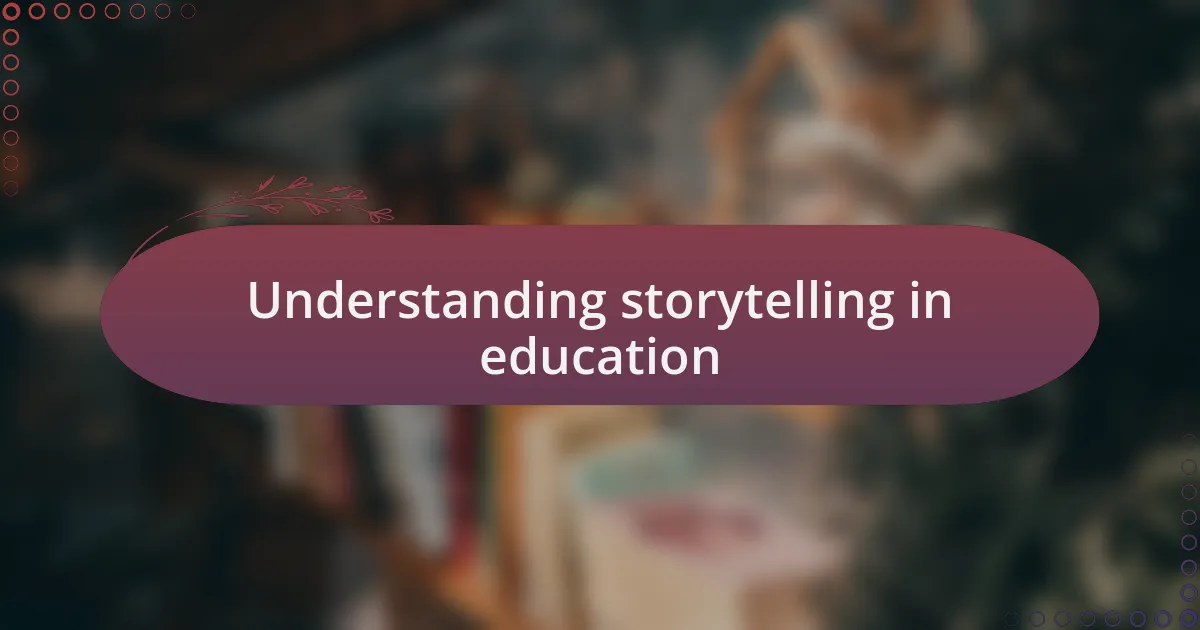
Understanding storytelling in education
Storytelling in education serves as a bridge between complex concepts and learner comprehension. I often find that when I weave narratives into my lessons, students don’t just absorb facts; they connect emotionally with the material. Have you ever noticed how a good story lingers in your mind long after it’s been told? This emotional resonance is why storytelling is not just effective; it’s essential.
In my experience, students engage more deeply when they see themselves or their experiences reflected in a story. For instance, during a history lesson on civil rights, I shared a personal story about a relative who marched for equality. The room grew quiet, and I could see their eyes light up with understanding. It’s a moment I cherish because it illuminated how a simple personal narrative could ignite discussions on empathy and social justice.
Moreover, storytelling fosters a sense of community in the classroom. When I invite students to share their own stories, it creates an inclusive environment that celebrates diverse perspectives. Can you imagine how much richer our discussions become when every voice has a chance to be heard? This not only enhances learning but also builds connections among students, turning the classroom into a vibrant space for exploration and growth.
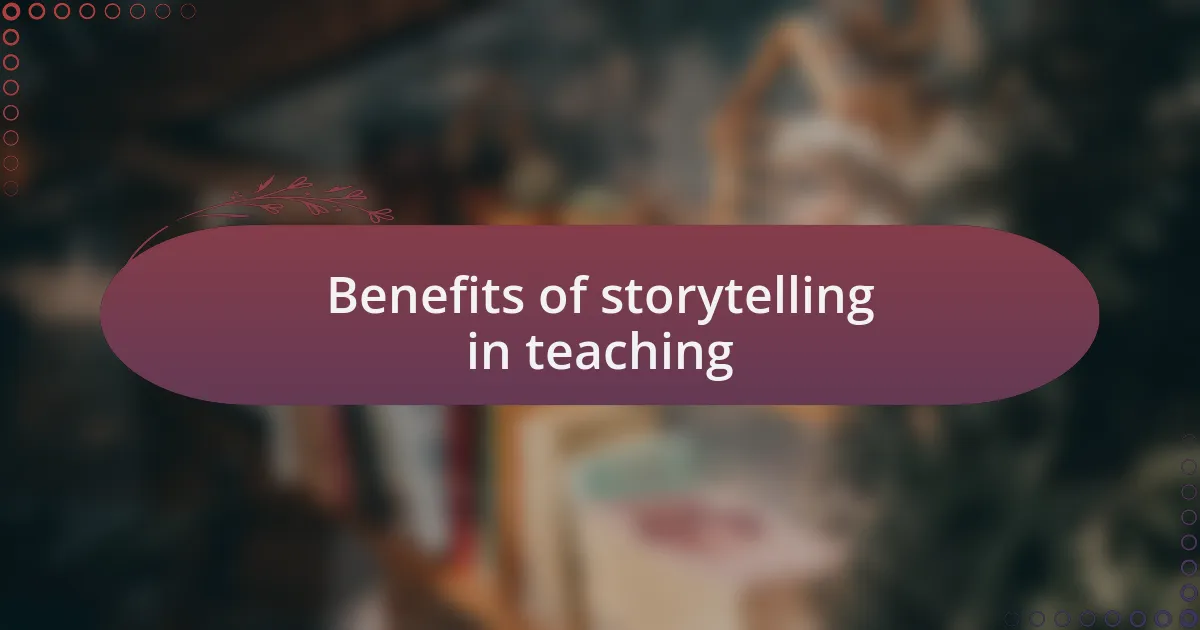
Benefits of storytelling in teaching
One significant benefit of storytelling in teaching is its ability to improve memory retention. I’ve observed that when students hear a well-crafted story, they remember the information far better than if I merely presented facts. Have you ever recalled a lesson more vividly because of a story attached to it? This experiential learning reinforces concepts by tying them to memorable narratives, making long-term retention much more likely.
Additionally, storytelling enhances critical thinking skills. By analyzing stories, students learn to dissect plotlines, motivations, and outcomes. I often encourage my students to question the decisions of a character in a story I share, prompting them to think beyond the text. How would they respond in that situation? This reflection not only deepens their understanding of the material but also develops their problem-solving abilities in real-life contexts.
Moreover, storytelling helps build an emotional connection between the teacher and students, fostering trust and openness. I remember a time when I told a humorous anecdote about a personal classroom mishap. The laughter that followed broke down barriers and allowed students to feel more comfortable sharing their thoughts and experiences. It’s beautiful how storytelling creates a relatable platform, transforming our classroom into a place where learning thrives on connection and camaraderie.
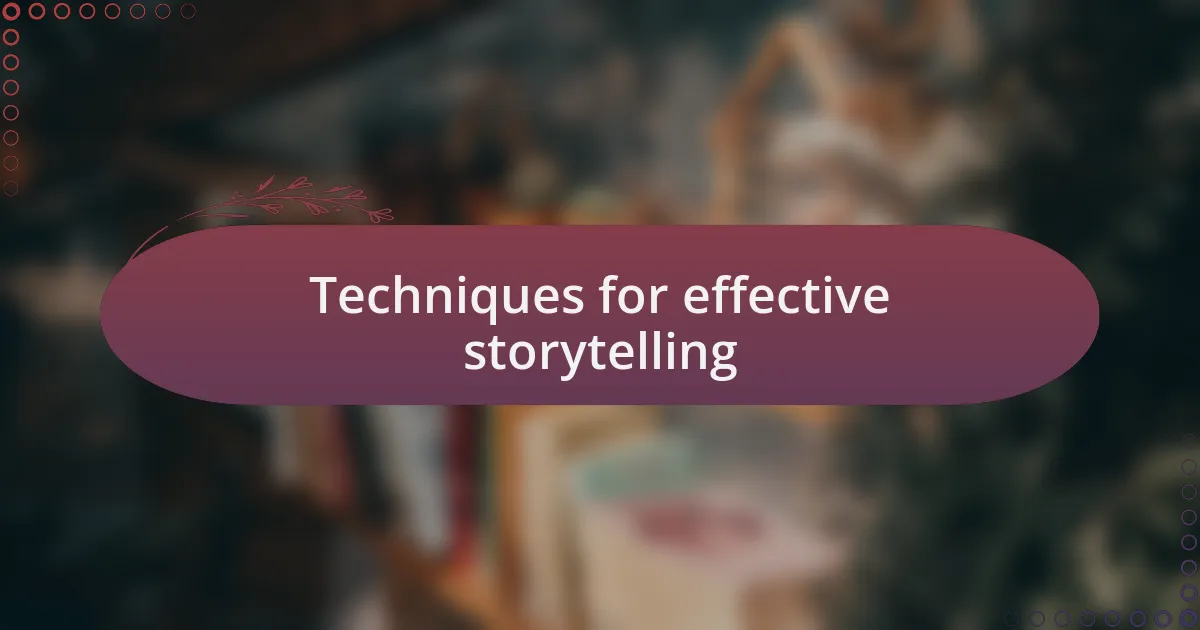
Techniques for effective storytelling
Imagine starting a lesson with a vivid scene that draws your students into a different world. I often use descriptive language that paints a picture in their minds, immersing them in the setting. When I tell a story about a historical figure’s journey, I emphasize the emotions they felt, making the narrative relatable. Isn’t it amazing how a few carefully chosen words can spark a student’s imagination and curiosity?
Another technique I employ is the incorporation of sensory details. In one of my science lessons, I shared a tale about a scientist’s groundbreaking discovery, weaving in visuals and sounds that reflect the excitement of the moment. I asked students to close their eyes and envision the laboratory filled with bubbling beakers. This not only captivates their attention but also helps them connect the lesson to real-world experiences, making the concepts more tangible.
To make my storytelling even more engaging, I frequently invite students to contribute their ideas and interpretations. During discussions, I often prompt, “What do you think would happen if the character took a different route?” This invites them to think critically and engage with the material on a deeper level. It’s incredible how a simple question can lead to a lively exchange of thoughts, enriching everyone’s understanding and making the learning process a shared journey.
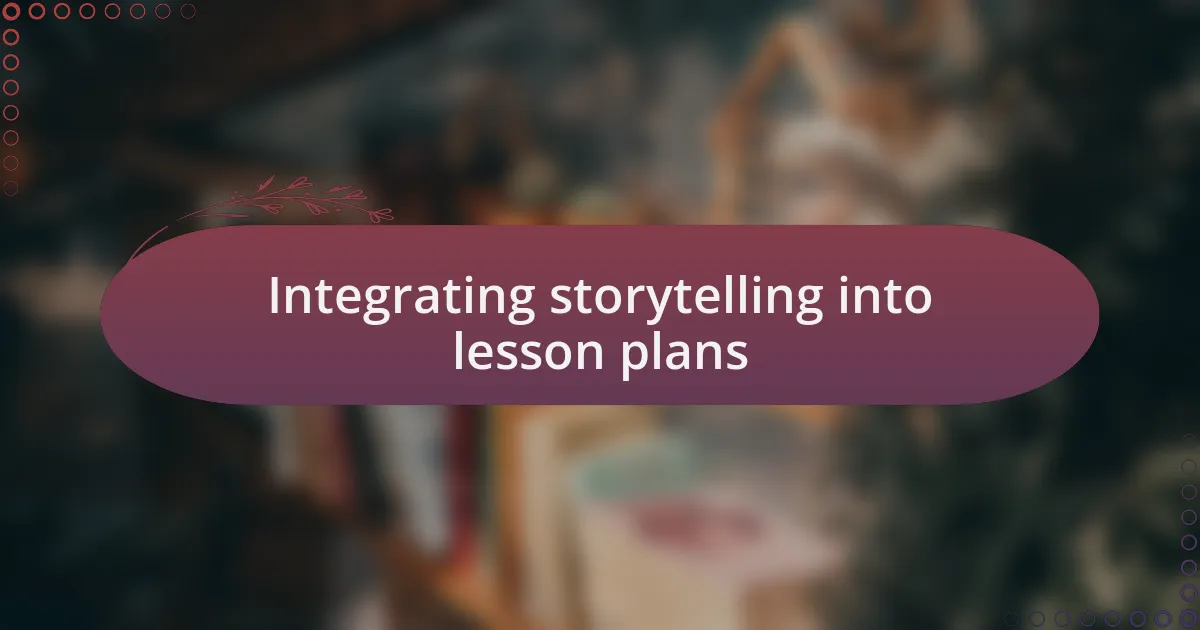
Integrating storytelling into lesson plans
When I plan a lesson, I always look for ways to weave storytelling into the fabric of my curriculum. For instance, while teaching literature, I create a narrative arc around the themes we’re discussing, transforming standard lessons into journeys full of conflict and resolution. Have you ever noticed how a well-placed story can turn abstract concepts into gripping experiences? I find that this transformation keeps students invested and eager to learn.
Incorporating stories from different cultures can also provide valuable insights and broaden perspectives. Once, I shared a folktale from a culture vastly different from my students’ own. Watching their faces light up as they identified the universal themes of love and sacrifice stirred a deep conversation. It was a moment when I realized that storytelling isn’t just about facts; it connects us to our shared humanity.
I often create opportunities for my students to tell their own stories related to our lessons, making the learning experience even more personal. I recall a time when a student shared a family story while we were discussing perseverance. The classroom atmosphere shifted as we all felt the weight of her words, creating a bond of empathy. Have you ever seen how one shared story can unite a group? It’s moments like these that bring alive the power of storytelling in education.
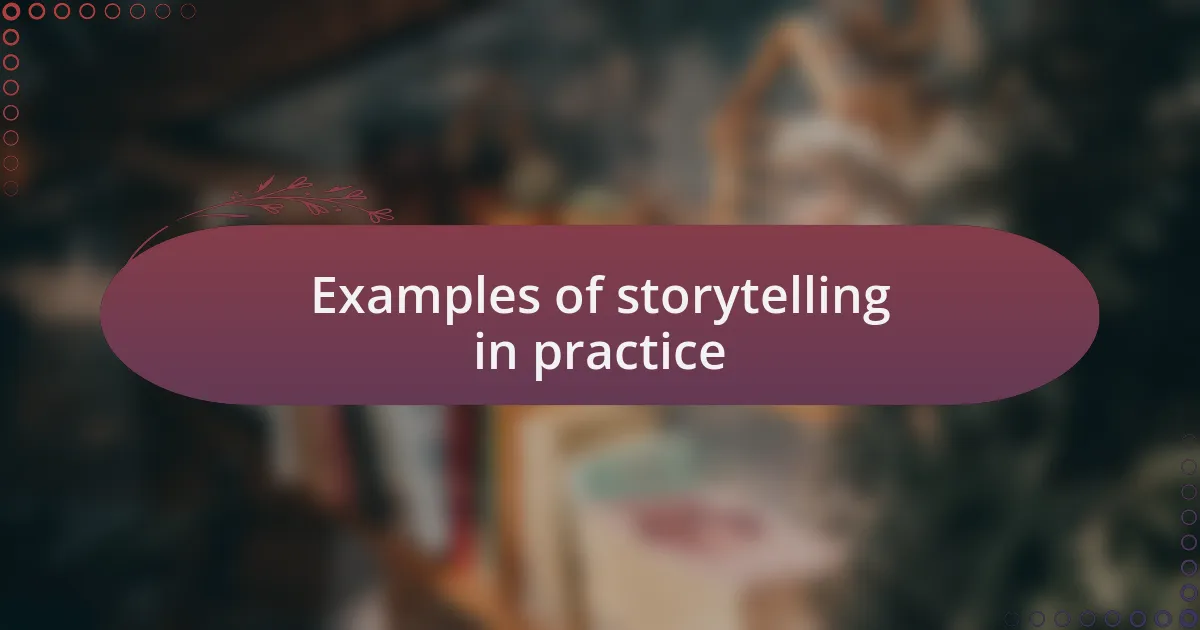
Examples of storytelling in practice
One effective way I use storytelling in practice is through role-playing scenarios in my classroom. For example, while teaching historical events, I have students assume the identities of key figures, creating a narrative that allows them to explore diverse perspectives. I still remember a session where students embodied leaders from different eras during a debate. The excitement was palpable, and I could see their comprehension deepen as they articulated their characters’ motivations. Isn’t it amazing how stepping into someone else’s shoes can foster empathy and a better understanding of complex events?
Another powerful storytelling technique involves using picture books, even for older students. I recall a time when I introduced a striking illustrated book to explore themes of identity and belonging. The vivid imagery sparked curiosity and conversation; it was as if the words came alive in our minds. How often do we overlook the value of visuals in storytelling? That session not only expanded their understanding but also encouraged students to express their thoughts about their own identities through creative writing.
Finally, I frequently share personal anecdotes that relate to the curriculum. I distinctly remember discussing the scientific method and drawing from a mishap in a science experiment I conducted in school. My admitted blunder lightened the mood and made the concept more relatable, transforming what could have been a dry lesson into a memorable moment. Have you ever noticed how sharing a personal experience can break down barriers and make the material feel more accessible? That’s the magic of storytelling; it turns education into an experience we all share.
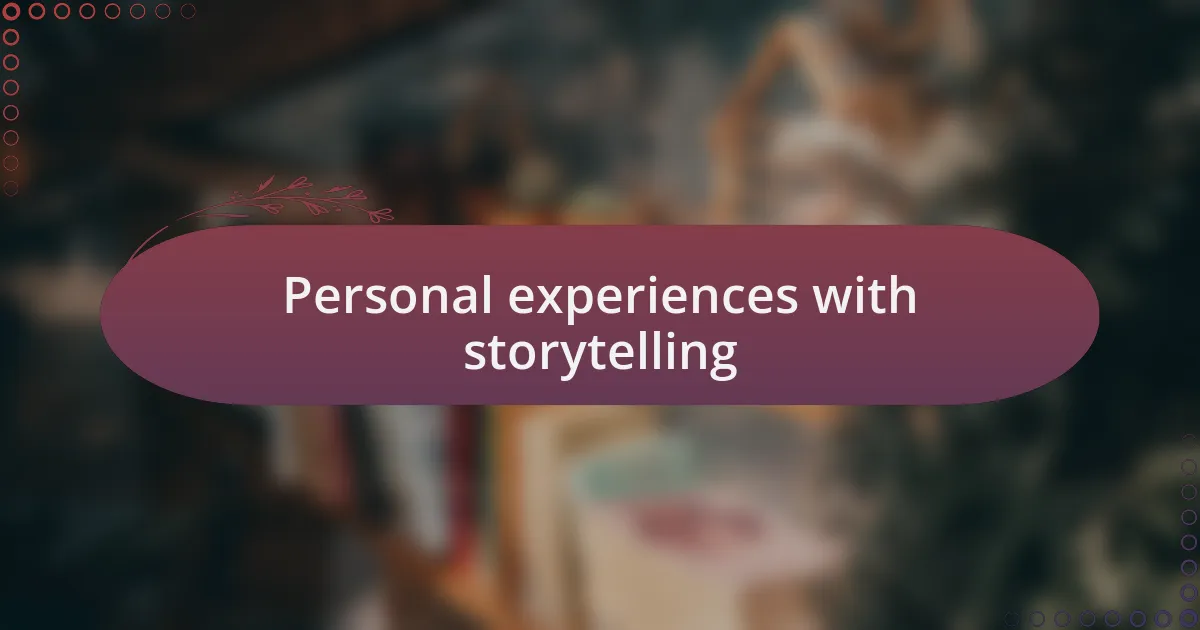
Personal experiences with storytelling
As I think back to my own school days, storytelling played a pivotal role in my learning. I remember one teacher who shared a heartfelt story about her childhood struggles, weaving it into the lesson on perseverance. The way she spoke, with genuine emotion, resonated with me. It made the concept of resilience feel not just theoretical, but deeply personal. Have you ever had a moment like that, where a story broke through the barriers of just rote memorization?
Another memorable experience was when I read aloud from a culturally significant novel, inviting students to make connections to their own lives. One student, who often struggled to engage, lit up and began to share his own stories. It was as if the book had unlocked a hidden door. Isn’t it incredible how a simple narrative can unleash thoughts and emotions that have been waiting to be expressed?
A specific moment that stands out happened during a tough discussion on mental health. I chose to share a challenging time I experienced and how storytelling itself helped me process my feelings. As I spoke, I noticed students nodding, with some even sharing their own experiences afterward. It struck me then—storytelling isn’t just about the lesson; it’s about creating a safe space for vulnerability and connection. Have you ever felt that powerful shift in the classroom atmosphere when you open up?
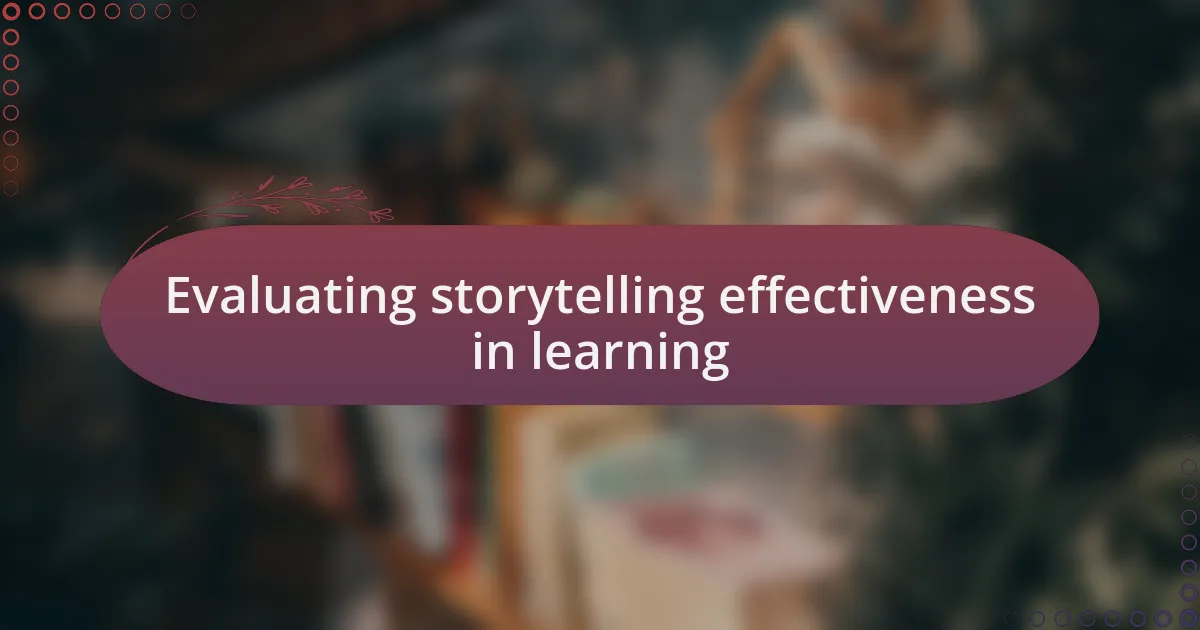
Evaluating storytelling effectiveness in learning
When evaluating the effectiveness of storytelling in learning, I often reflect on how students react to stories versus traditional teaching methods. For instance, during a history lesson, I narrated a historical event through the eyes of a young participant, which transformed the abstract facts into something tangible. The questions that followed were not about dates or timelines; they were about feelings and motivations—real conversations that I rarely witnessed during a standard lecture. Isn’t it fascinating how a narrative can lead to deeper engagement?
Moreover, I’ve noticed that storytelling fosters retention more than mere memorization. After sharing a story related to a scientific concept, I would conduct a simple quiz. Surprisingly, students recalled details better when those details were embedded in a narrative. This has led me to question conventional assessment methods—what if we incorporated storytelling elements into evaluations to measure not just knowledge, but understanding and personal connection as well?
In my experience, the emotional component of storytelling significantly influences learning outcomes. I once introduced a lesson on community responsibility through a tale about a local hero. Students not only absorbed the lesson but also expressed a heightened sense of responsibility towards their own community projects afterward. Have you seen the way a well-told story can spark motivation or action in students? It’s a reminder that learning is not just cognitive; it’s profoundly emotional, too.